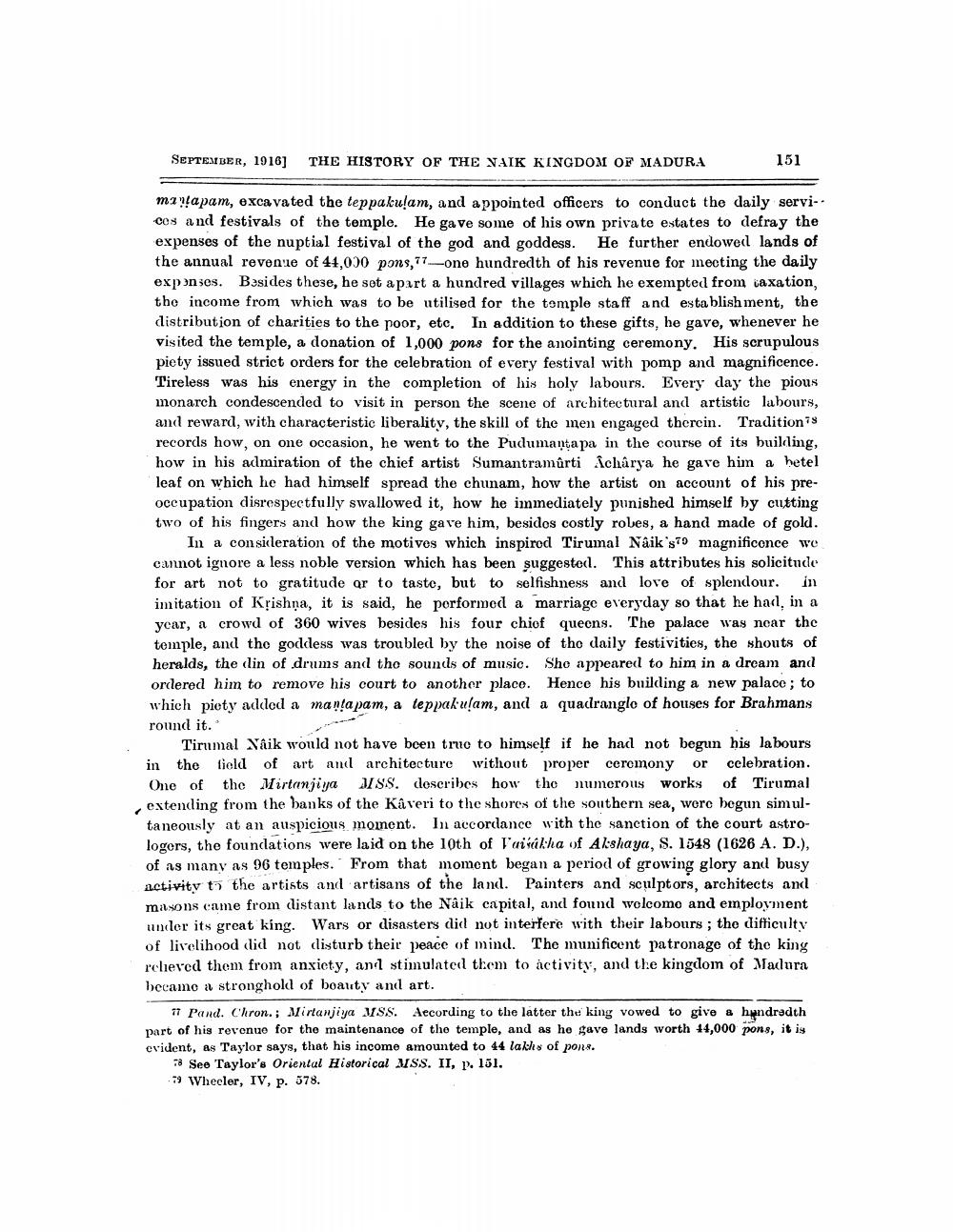________________
SEPTEMBER, 1916]
THE HISTORY OF THE NAIK KINGDOM OF MADURA
151
mayapam, excavated the teppakulam, and appointed officers to conduct the daily services and festivals of the temple. He gave some of his own private estates to defray the expenses of the nuptial festival of the god and goddess. He further endowedl lands of the annual revenue of 41,000 pons, 77--one hundredth of his revenue for meeting the daily exponses. Besides these, he set apart a hundred villages which he exempted from vaxation, the income from which was to be utilised for the temple staff and establishment, the distribution of charities to the poor, etc. In addition to these gifts, he gave, whenever he visited the temple, a donation of 1,000 pons for the anointing ceremony. His scrupulous piety issued strict orders for the celebration of every festival with pomp and magnificence. Tireless was his energy in the completion of his holy labours. Every day the pious monarch condescended to visit in person the scene of architectural and artistic labours, and reward, with characteristic liberality, the skill of the men engaged therein. Traditionis records how, on one occasion, he went to the Pudumantapa in the course of its building, how in his admiration of the chief artist Sumantramûrti Acharya he gave him a hetel leaf on which he had himself spread the chunam, how the artist on account of his preoccupation disrespectfully swallowed it, how he immediately punished himself by cutting two of his fingers and how the king gave him, besidos costly roles, a hand made of gold.
In a consileration of the motivos which inspired Tirumal Naik 's magnificence we cannot ignore a less noble version which has been suggested. This attributes his solicitude for art not to gratitude or to tasto, but to selfishness and love of splendour. in imitation of Krishna, it is said, he performed a marriage everyday so that he had, in a year, a crowd of 360 wives besides his four chiof queens. The palace way near the temple, and the goddess was troubled by the noise of the daily festivities, the shouts of heralds, the clin of drums and the sounds of music. Sho appeared to him in a dream and ordered him to remove his court to another place. Hence his building a new palace; to which picty added a mantapam, a teppakulam, and a quadranglo of houses for Brahmans round it.
Tirumal Xaik would not have been true to himself if he had not begun his labours in the field of art and architecture without proper ceremony or celebration. One of the Mirtanjiya DISS. describes how the numerous works of Tirumal extending from the banks of the Kaveri to the shores of the southern sea, were begun simultaneously at an auspicious moment. In accordance with the sanction of the court astrologers, the foundations were laid on the 10th of Taidkha of Akshaya, S. 1548 (1626 A. D.), of as many as 96 temples. From that moment began a period of growing glory and busy activity to the artists and artisans of the land. Painters and sculptors, architects and masons came from distant lands to the Naik capital, and found welcome and employment under its great king. Wars or disasters did not interfere with their labours; the difficulty of livelihood did not disturb their peace of mind. The munificent patronage of the kiny relieved them from anxiety, anil stimulated them to activity, and the kingdom of Macura became a stronghold of boauty and art.
17 Pand. Chron. ; Mirtanjiya SS. Aecording to the latter the king vowed to give a hundredth part of his revenue for the maintenance of the temple, and as ho gave lands worth 44,000 pons, it is evident, as Taylor says, that his income amounted to 44 lakhs of pons.
13 See Taylor's Oriental Historical MSS. II, p. 151. 19 Wheeler, IV, p. 578.




